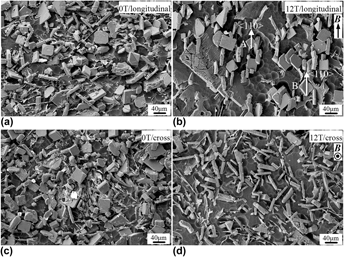Published online by Cambridge University Press: 06 February 2017

The effects of high magnetic fields on the solidification structures of ternary Al–Fe–Zr alloy were investigated. The results showed that the primary Al3Fe crystals mainly show bar-like form, whereas the unmelted Al3Zr crystals reveal tabular and the newly crystallized primary Al3Zr crystals have fine/coarse needle-like forms. When a 12 T magnetic field is applied, the primary Al3Fe crystals are distributed homogenously and the fine needle-like primary Al3Zr levitated. Moreover, the primary Al3Fe crystals align horizontally in the upper but vertically in the lower part of the specimen. The needle-like primary Al3Zr crystals align vertically, whereas the tabular ones have their two opposite corners on the large surfaces toward the positive and negative magnetic field direction. Crystallographic analysis indicates that 〈100〉 and 〈110〉 are the preferred axes of the primary Al3Fe and the Al3Zr crystals with respect to the magnetic field, respectively. The redistribution and realignments of the crystals are discussed.
Contributing Editor: Jürgen Eckert